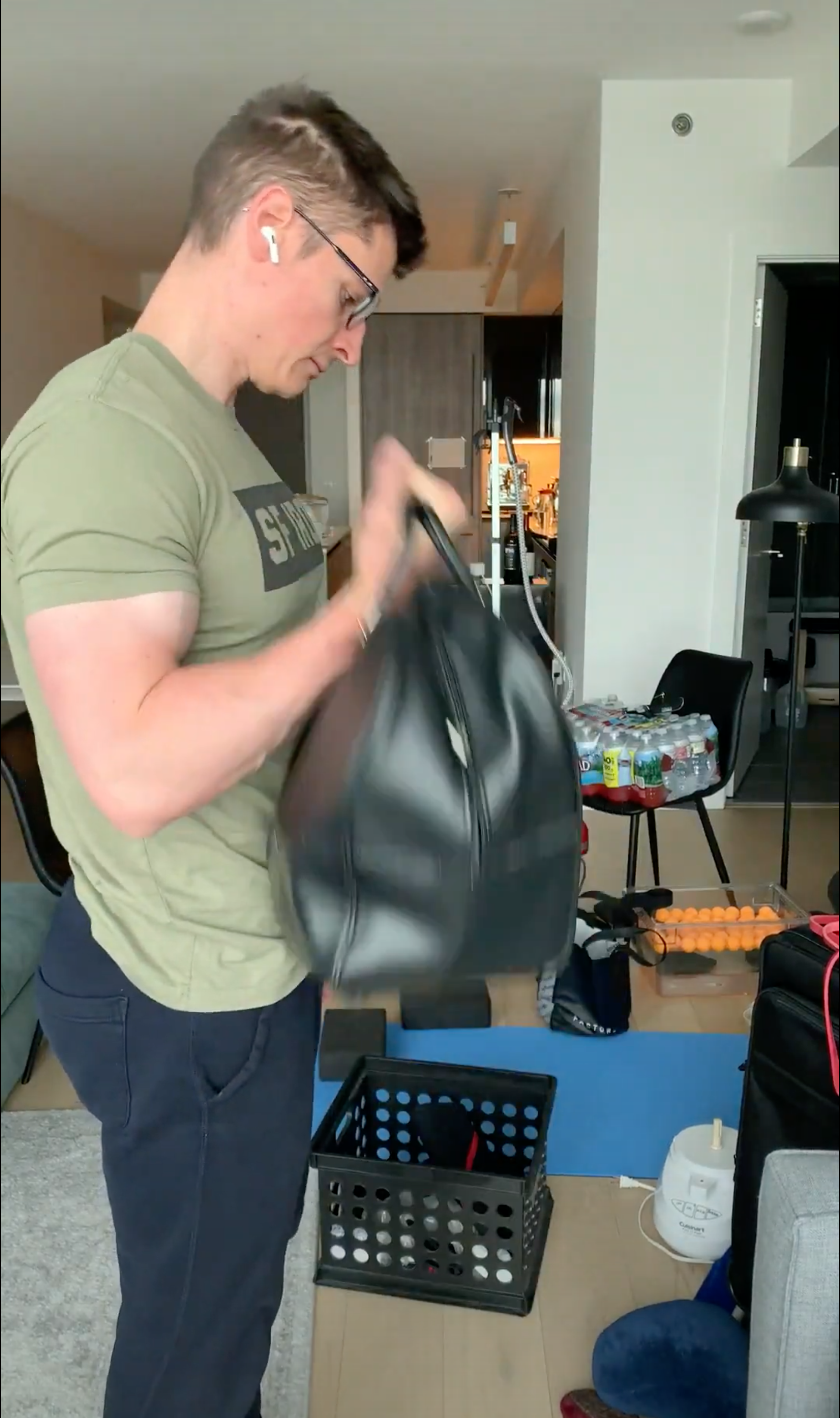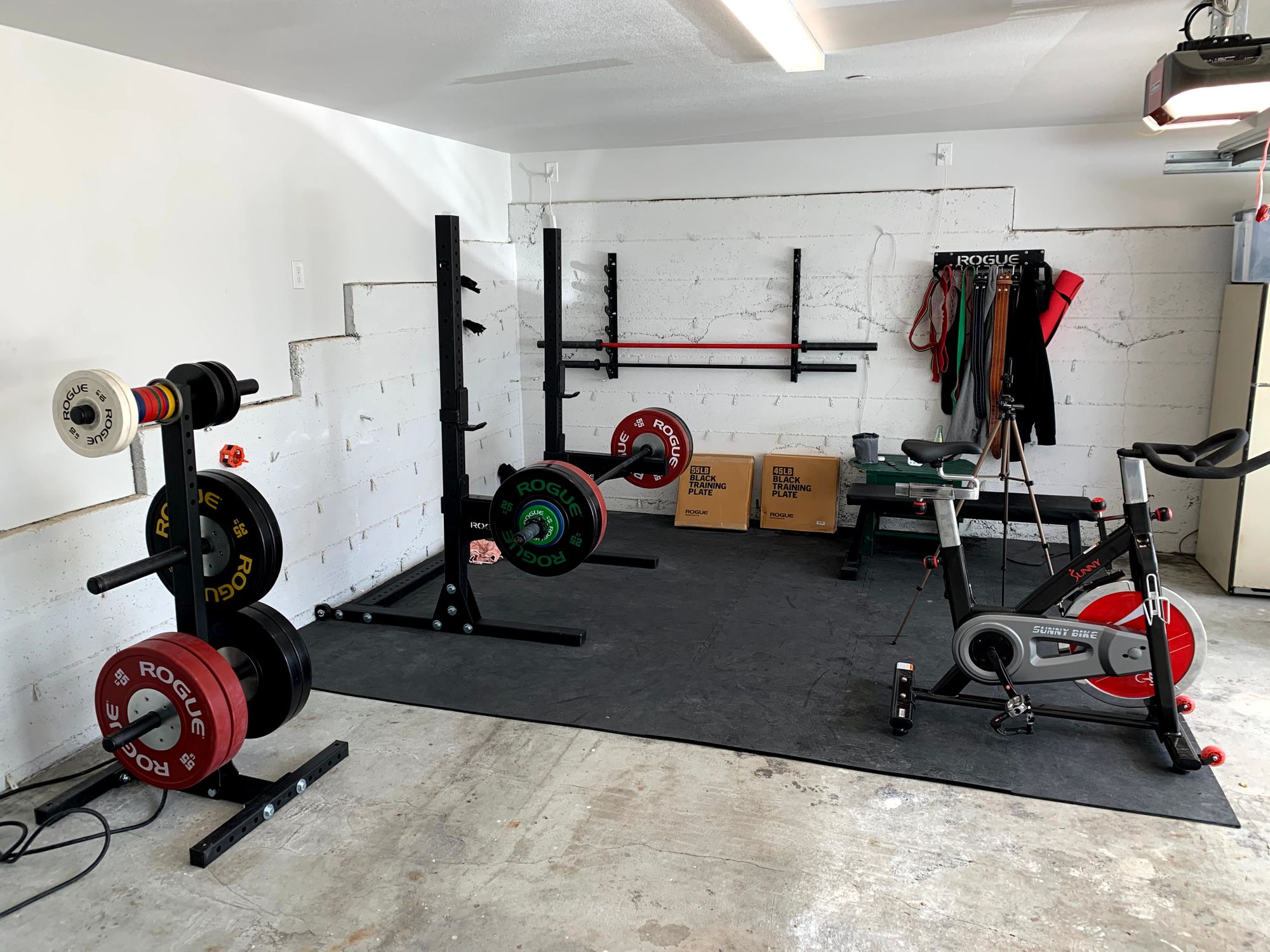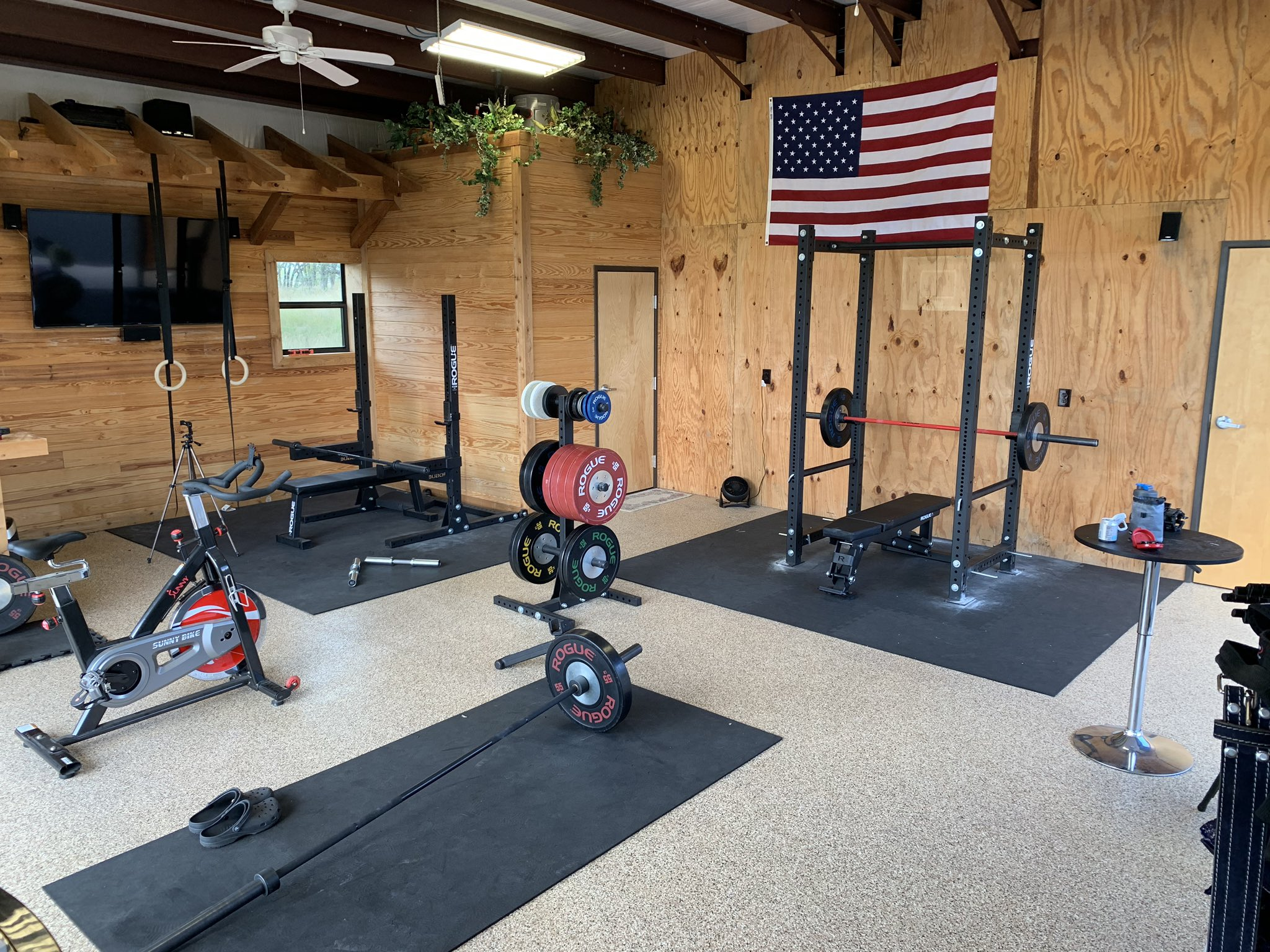The Sovereign Lifter: Building your home gym
Why and how to build a good home gym.

Every strength athlete knows how important consistency is to making and preserving gains. Missing a little as two weeks of training can be a major setback, especially if you're advanced. When COVID-19 came to America, many state and local governments ordered gyms to close. As cities started to lock down, lifters were forced to preserve what gains they could by doing bodyweight exercises and creating makeshift weights using random heavy objects around the house.

People with the space, and those who were able to quickly obtain it by moving to a bigger home, were able to build a home gym. For us, the pandemic was just a hiccup. Gym equipment sold out quickly and has remained in low supply (or at inflated prices) for almost a year now, but it hasn't been impossible to get. In my case, I moved from San Francisco to a rental house outside the city with a big garage. I was able to order everything I needed by diligently monitoring Rogue Fitness for restocked equipment.

Lifters in states that have minimized lockdowns, such as Texas and Florida, have also been able to continue training. But the rest of the states have continued to sporadically lock down, requiring gyms to close and limit capacity. Only a few gyms have disobeyed lockdown orders, most famously Atilis Gym in New Jersey. Lifters in these states have been hard-hit. We now know for sure that governments in these places, given a sufficient excuse, can revoke your access to gyms, effectively taking away your gains.
We shouldn't minimize the vast loss of life that has occurred because of COVID. But we shouldn't consider the loss of physical fitness due to lockdowns a trivial one either. As strength athletes and bodybuilders, we don't invest so much of our energy into training only out of vanity. We do it to enhance our vitality and stay healthy — physically, mentally, and spiritually. Being strong makes you feel confident, optimistic, and generous. Being weak makes you fearful, spiteful, and lethargic. When a man's physical gains are taken away, he becomes a worse person. He becomes irritable, lacks the courage to stand up for himself, and wants to bring others down with him. He becomes more vulnerable not only to physical viruses like COVID, but to manipulative mind viruses.

The most practical, simple, and peaceful way for us to protect and preserve fitness in the future is to build home gyms. Anyone with a home gym can stay fit regardless of what those in power decide. Just as we hold Bitcoin to make it harder for our wealth to be confiscated, we should hold gym equipment to make it harder for our strength and vitality to be confiscated. While governments have flexed their dominance over small businesses this year, we've also seen that they can't control what goes on in our homes as easily. Businesses have been required to shut down, but people have still been able to meet in person without any real fear of punishment. In a few cases, cities have shut off utilities to homes to keep people from congregating, but this has been rare.
Reasonable people can disagree about whether it made sense to allow gyms to remain open during the pandemic, helping people stay fit and robust but permitting another place for the disease to spread. If you agree with gym lockdowns, you should be even more enthusiastic about home gyms. They allow everyone can stay fit with no risk of spreading disease.
Home gyms in normal times
We should always overcompensate for disasters like COVID so that we're prepared for similar or worse situations the future. That's enough of a reason to build a home gym. But even in normal times, when we're not being controlled in such an overt way, we should have home gyms.
Every lifter intuitively craves a home gym. Some people are fortunate enough to live near a hardcore, "anything goes" gym like Iron Sport in Folsom, PA, Hyde Park Gym in Austin, TX, or Fortis Fitness in Toronto, Canada, or a personal training-oriented strength gym like SF Iron in San Francisco, where I trained. If not, you have two options: train at a mainstream commercial gym (e.g. Crunch or Equinox) or do CrossFit.
Mainstream commercial gyms are designed for casual gym-goers and tend to be less than ideal for lifting. They don't allow you to drop the weights (or force you to use Pound Pads / heavily padded areas), making it annoying to deadlift. They often discourage the use of chalk — essential for securely gripping a barbell — making it unsafe to lift heavy. They rarely have enough squat racks; you have to wait a long time to squat, and you feel rushed once you get a rack. They clean the gym way too aggressively while the gym is open; I've had cleaning people mop the floor inside the squat rack I was using between sets, making the floor slippery and unsafe.
CrossFit gyms let you use chalk and drop weights, but they force you to train with a large group and in a short time window, making it less than ideal for making consistent, methodical gains on your own schedule. CrossFit gyms usually only have the most basic equipment: barbells, bumper plates, and racks. The equipment tends to be worn out due to weather exposure and intense use by large numbers of sweaty people.
With a home gym, you can get the exact equipment you need, never have to share it, and work out whenever you want. You never have to follow any oppressive, safety-reducing rules.
Training in a home gym-compatible way
The best way to build strength and size is to focus on the big compound lifts: deadlift, squat, and bench press. Check out Starting Strength by Mark Rippetoe to get up to speed on this. One secondary benefit of training in this way is that you can train your entire body without much equipment: just a barbell, plates, a squat rack, and a bench. This makes it easy and cheap to build a home gym that meets all your training needs.
Many beginners limit their training to gym machines. They do this because machines are easy to get started with without a trainer. Among the many downsides of training with machines, they're extremely impractical for a home gym. They're large and expensive, and each one trains only a small, isolated muscle group. You need to stop training this way and start training with a barbell.
But how do you learn how to train with a barbell? How do you avoid injuring yourself? These days it's easy to find someone to train you online. You can set up a Zoom session where the trainer watches and gives you feedback, or you can record yourself and send videos to your trainer. I would not recommend jumping into this without any supervision.
Affording a home gym
You may be thinking that home gyms are a luxury only accessible to the rich. Wrong. To build a decent home gym, you just need about 100 square feet of ground floor space, a barbell, weights, a squat rack, and a bench. Depending on where you live, the space can even be semi-outdoor (like a garage or shed). The minimum viable strength gym only costs around $1600 (plus tax and shipping) if you buy it all from Rogue, which is one of the pricier brands.
Your home gym pays for itself pretty quickly if it allows you to cancel your gym membership. It also saves you the time of commuting to and from a commercial gym. If you maintain your equipment properly, it will last for decades. Pre-COVID, you may have sunk years of gym membership fees and huge amounts of time training, only to lose all your gains as soon as the gyms locked down. With a home gym, you can be more confident that your hard-earned gains will be preserved no matter what's going on in the outside world.
The part of a home gym that can actually be quite expensive is not the equipment, but the floor space. Cost of floor space is completely dependent on where you live. Almost no one can afford space for a decent home gym in Manhattan or San Francisco. But most people who were living in these hyper expensive places pre-COVID can now work remotely. Even after the pandemic is over, many companies will remain fully remote. And if you work at a company that asks you to come back to the office, you can apply to other companies that will allow you to stay remote.
If you're confident that you will be able to work remotely for years into the future, you can just leave your dense city and return to a lower cost rural or suburban area where space for a gym is cheap. Given the trend towards remote work, traffic will probably remain lower than pre-COVID for a while. So even if you decide to go back to commuting to an office, you may be able to live further from the city with an easier commute than pre-COVID. Self-driving vehicles are also on track improve significantly in the next decade, making commute time even less of a concern.
Bad home gyms
I appreciate and admire all the startups that are making home fitness setups easier and more accessible. That said, if you're looking to build a powerful physique, many of the current options are overpriced and lacking in functionality.
What about Tonal? Can't you just install one of these and get strong in your tiny apartment? No. Tonal only goes up to 100 lb per handle, for a total of 200 lb. Even when I first started lifting, I exceeded 200 lb on my deadlift within a couple months. You aren't going to get strong lifting 200 lb. It's quite expensive at $3K — almost double the cost of a complete set of basic lifting equipment. Tonal seems decent for accessory work like building your arms; but even then, it's extremely cost-inefficient for those exercises.
What about Tempo? Tempo is like Tonal but with a barbell and loadable dumbbells. It comes with a 25 lb barbell, loadable dumbbells, and 75 lb of weights. Again, this is not nearly enough weight to get strong. Deadlifting 100 lb won't get you anywhere. It doesn't come with a squat rack or bench, so you're very limited on what kinds of exercises you can do. And it costs $2K — more than the cost of the minimum viable barbell gym for much less functionality.
What about bodyweight exercises? You just aren't going to get very strong this way. It's better than nothing, and you can definitely put on some muscle this way. But fundamentally you only weigh so much. Steel is the best tool for building big muscles.
Finding space for your home gym
The room you use for your gym must have a flat, level, sturdy floor. The ceiling must be high enough for you to shoulder press. You should be able to drop the barbell without breaking the floor and without making noise and shaking the building in a way that bothers your neighbors. If your floor isn't flat and level, squatting and deadlifting may be dangerous and awkward, your bench may rock, and your barbell will roll on the floor. In this case, you can build a level wooden platform over the floor.
You should be able to keep your gym temperature in a comfortable range. For me that's 65-85 °F. It should be protected from the elements to prevent your gear from rusting. In certain climates, this means can be in a covered outdoor area or garage. Otherwise it's better for it to be an indoor, insulated room. That said, lifting in uncomfortable temperatures, if necessary, is good for you; it drives healthy adaptations. Just make sure you warm up when your gym is cold and stay hydrated when your gym is hot.
Equipping your home gym
I buy as much of my equipment as possible from Rogue Fitness. They have high-quality gear at reasonable prices. Since the COVID outbreak, their supply has been limited, but you can sign up to be notified when items you want become available. That said, the most important thing is having a home gym at all; it's much better to have lower-quality equipment than none at all.
The first thing you need is a barbell. I use the Ohio Power Bar for bench and squat and the Ohio Deadlift Bar for deadlifts, but the Ohio Bar is a good general-purpose bar. I went with the Cerakote coated bars because of availability, but I'd probably go with stainless steel, the most durable option, in the future.
The next thing you need is plates. I prefer Rogue Training Bumper Plates because you can safely drop them and they aren't super bouncy (unlike Rogue Competition Bumper Plates which are very bouncy). They also have a very low weight tolerance; i.e. the stated weight is very accurate. Rogue Olympic Plates are a good lower-cost option; they're just louder when dropped on the floor and aren't as accurate as rubber-coated plates. Plate accuracy is not that important for training unless you are super advanced; it's only important in actual competitions. I use a Rogue Vertical Plate Tree for plate storage, but there are many other options.
Once you have a barbell and plates, you can at least do floor exercises like deadlifts, power cleans, and rows.
To bench and squat, you need a squat rack. I initially went with the Rogue SM-1 Squat Stand, the most compact Rogue rack. It's great if your ceiling is low and you don't want to drill into the floor or walls. After moving to a place with a high ceiling and a floor I could drill into, I added a Rogue RML-3 Power Rack. Lifting in a full rack that's attached to the floor is safer and feels more secure, especially for high intensity sets.
Finally, to bench, you'll need a bench. I initially purchased the Rogue Flat Utility Bench but ended up also buying the Rogue Adjustable Bench. I would recommend just going for the adjustable bench if you can.
To protect your floor, you should put down rubber flooring. Many people use horse stall mats for this. I went with fit-lock mats because they were easier to get delivered and made the flooring layout more customizable. My mats are 3/8" thick, and this thickness has worked well with rubber-coated/bumper plates. If you're using bare steel plates, you should probably go with thicker mats to protect your floor and the plates.

With a barbell, weights, rack, bench, and flooring, you have everything you need to get strong. There are a few more things I'd recommend for accessory work:
- Loadable dumbbells. There's no need to buy an enormous set of dumbbells like what commercial gyms have. There are many options for a compact set of dumbbells, but for me the loadable dumbbells were the easiest to find and have worked pretty well.
- Cable pulley system. This allows you to do cable exercises with your plates instead of a big cable machine. At about $200, it's more than 10x cheaper than a $3K Tonal for similar functionality.
- Cardio machine such as a stationary bike or rowing machine. Health benefits aside, cardiovascular capacity helps you get through squat and deadlift sets of 6 or more. I have this spin bike which has worked fine for my basic needs, but assault bikes and rowing machines are probably better since they spread the load over more of the body.
- Gymnastic rings. These are a decent minimalistic tool for bodyweight accessories like pull-ups and dips. I used these a lot before I had a rack with a pull-up bar.
- American flag. America stands for freedom, independence, and private property. Your home gym embodies all of these values. Never let them take these things away!
